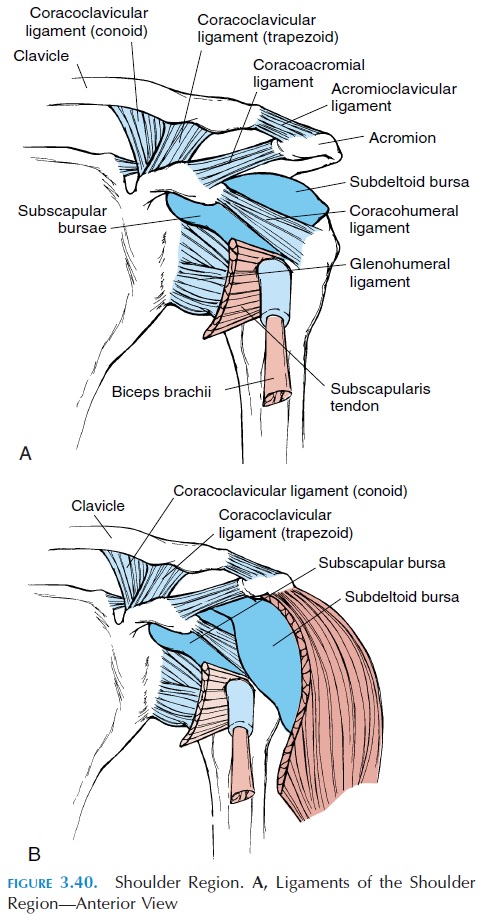Chapter: The Massage Connection ANATOMY AND PHYSIOLOGY : Skeletal System and Joints
Glenohumeral Joint

GLENOHUMERAL JOINT
Articulating Surface and Type of Joint
This joint is formed by the head of the humerus and the glenoid fossa of the scapula. It is a ball-and-socket

The shallow glenoid fossa is deepened by the presence of a circular band of fibrocartilage, the glenoidlabrum. The head of the humerus is prevented tosome extent from upward displacement by the pres-ence of the acromion and coracoid processes of the scapula and the lateral end of the clavicle. A number of ligaments (Figure 3.40A) help stabilize this joint further.
Ligaments
The glenohumeral ligament consists of three thick-ened sets of fibers on the anterior side of the capsule and extends from the humerus to the margin of the glenoid cavity. It prevents excess lateral rotation and stabilizes the joint anteriorly and inferiorly.
The coracohumeral ligament extends from the coracoid process to the neck of the humerus and strengthens the superior part of the capsule.
The coracoacromial ligament extends from the coracoid process to the acromion process.
The coracoclavicular and acromioclavicular lig-aments extend to the clavicle from the coracoidprocess and acromion, respectively.
The transverse humeral ligament extends across the lesser and greater tubercle, holding the tendon of the long head of the biceps in place.
Bursae
Two major and two minor bursae (Fig. 3.40B) are as-sociated with the shoulder joint. The subdeltoidbursa is located between the deltoid muscle and thejoint capsule. Thesubacromial bursa and the sub-coracoid bursa, as the names suggest, are locatedbetween the joint capsule and the acromion and coracoid processes, respectively. A small subscapu-lar bursa is located between the tendon of the sub-scapularis muscle and the capsule.
Possible Movements
Flexion, extension, adduction, abduction, circum-duction, and medial and lateral rotation are all possi-ble in this joint, and many muscles located around the joint help with movement. In addition, the shoul-ders can be elevated, depressed, retracted (scapula pulled together), and protracted (scapula pushed apart as in reaching forward with both arms).
For movements to occur at the shoulder, the func-tions of many joints and tissue must be optimal. Some contributing factors are the acromioclavicular joint, sternoclavicular joint, the contact between the scapula and the thorax, and the joints of the lower cervical and upper thoracic vertebrae. For example, the first 15–30° during abduction is a result of the glenohumeral joint. Beyond this, the scapula begins to contribute by moving forward, elevating and rotat-ing upwards, partly a result of movement at the ster-noclavicular and acromioclavicular joints. For every 3° of abduction, 1° occurs at the scapulothoracic ar-ticulation and the other 2° occur at the glenohumeral joint. Abduction using only the glenohumeral joint is possible up to 90°.
As the humerus elevates to 120°, the tension devel-oped in the joint capsule laterally rotates the humerus and prevents the greater tubercle from im-pinging on the acromion. At this point, the subdeltoid bursal tissue is gathered below the acromion. (If the bursa is swollen, it can result in restricted movement and/or injury to the tissue). Abduction beyond 160° occurs as a result of movement (extension) at the lower cervical and upper thoracic vertebrae. In uni-lateral abduction, the spine also rotates in the oppo-site direction of the moving arm.
Range of Motion
Flexion, 90°
Extension, 45°
Abduction, 180°
Adduction, 45°
Internal rotation, 55°
External rotation, 40–45°
Muscles
Many muscles participate in shoulder movement. Of these, the tendons of four muscles provide stability to the joint and are known as the rotator, or musculo-tendinous, cuff. The four muscles involved are thesupraspinatus, infraspinatus, teres minor, and sub-scapularis (you can remember it by the acronym SITS). The tendons of these muscles blend with the joint capsule. When the arm is hanging at the side, the tension of the superior aspect of the joint capsule is sufficient to keep the two articulating surfaces in contact. When the arm is moved from the side, the rotator cuff muscles must contract to keep the head of the humerus in position.
Muscles that help with flexion:
Primary flexors
Deltoid (anterior portion) Coracobrachialis
Secondary flexors
Pectoralis major Biceps brachii
Muscles that help with extension:
Primary extensors
Latissimus dorsi Teres major
Secondary extensors
Teres minor Triceps (long head)
The muscles that help with abduction:
Primary abductors
Deltoid (middle portion) Supraspinatus
Secondary abductors
Serratus anterior
Deltoid (anterior and posterior portions) The muscles that help with adduction:
Primary adductors
Pectoralis major Latissimus dorsi
Secondary adductors
Teres major
Deltoid (anterior portion)
Muscles that help with internal rotation:
Primary internal rotators
Subscapularis Pectoralis major Latissimus dorsi Teres major
Secondary internal rotator
Deltoid (anterior portion)
Muscles that help with external rotation:
Primary external rotators
Infraspinatus Teres minor
Secondary external rotator
Deltoid (posterior portion)
Muscles that help elevate the shoulder:
Primary elevators
Trapezius Levator scapulae
Secondary elevators
Rhomboid major Rhomboid minor
Muscles that help with scapular retraction (as in the position of attention or bracing the shoulder):
Primary retractors
Rhomboid major Rhomboid minor
Secondary retractor
Trapezius
Muscles that help with scapular protraction:
Primary protractor
Serratus anterior
Physical Assessment
It must be remembered that pain in the shoulder and arm could be referred pain from the myocardium, neck, and diaphragm.
After inspecting the skin and area around the joint for abnormal swelling, wasting of muscles, or discol-oration of the skin, the bony prominences and the muscles should be palpated for tender points. Then the range of motion should be tested both actively and passively.
If a person is unable to move his shoulder joint ac-tively through the normal range of motion, it could be a result of muscle weakness, tightening of the fi-brous tissue of the capsule or ligaments, or abnormal bony growths. Limitations as a result of muscle weakness can be ruled out if full range of movement is achieved by moving the joint passively. If the limi-tation persists even when moving the joint passively, the problem is probably a result of ligaments, cap-sule, or bony growths.
Related Topics